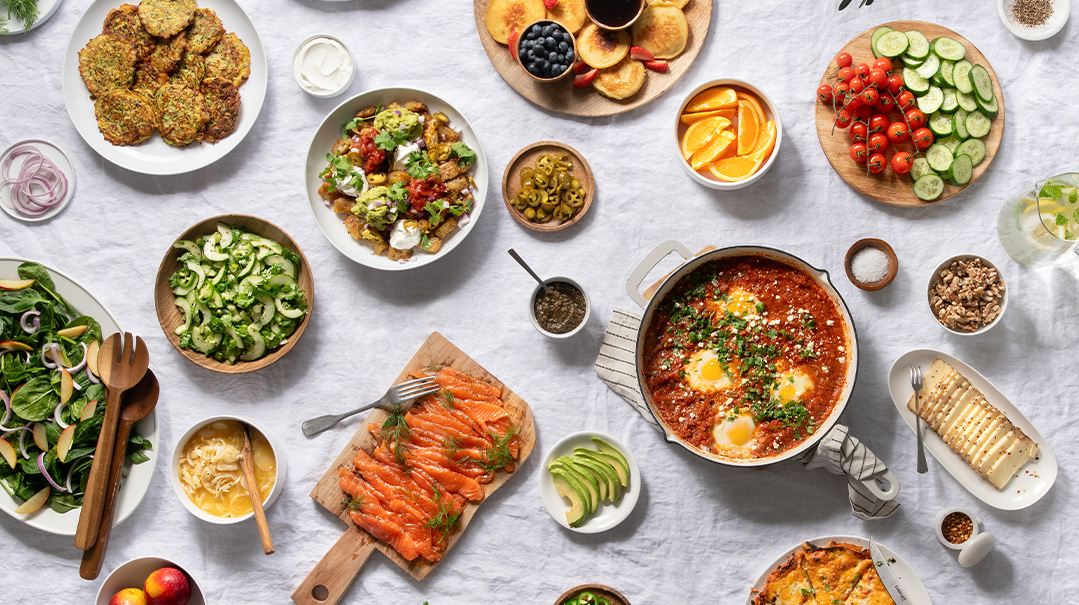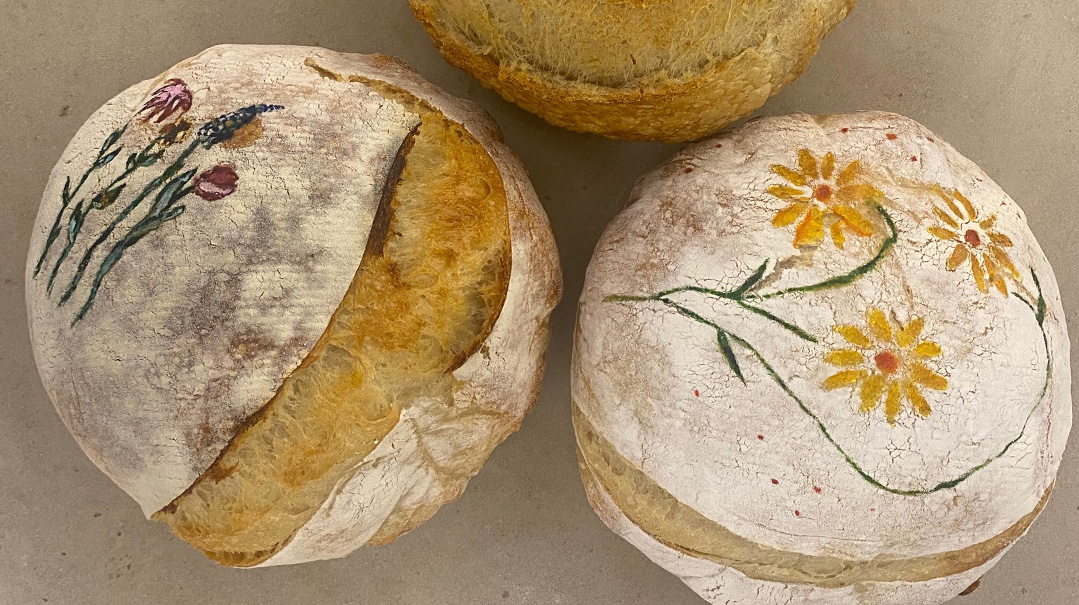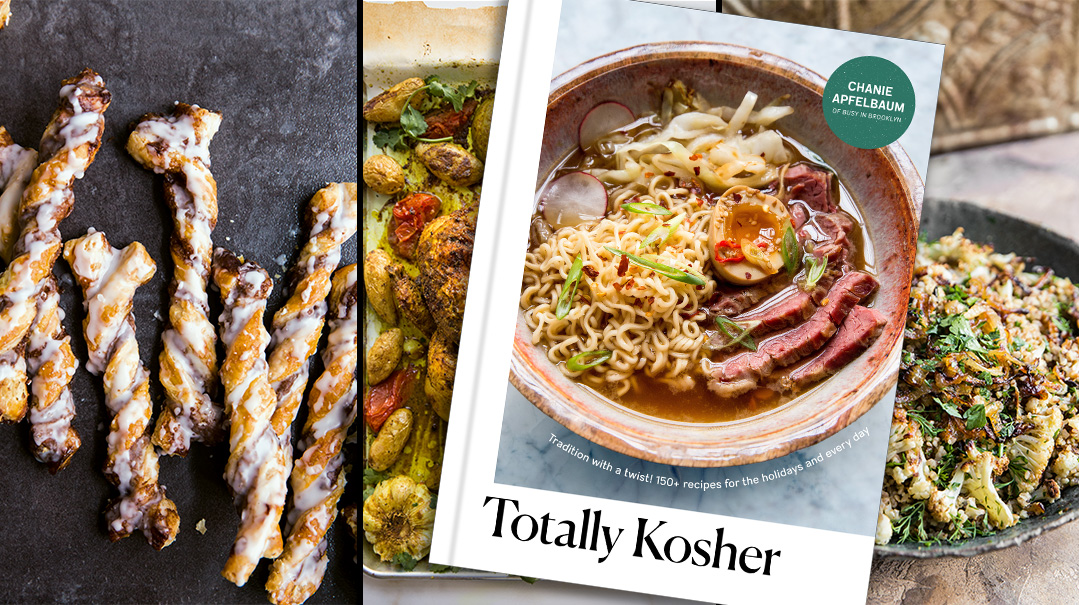Down to the Bones
| December 28, 2021
We put a lot of pressure on chicken soup; food for the soul, panacea for everything else. No one makes it as good as our mothers do, but no one’s mothers make it the same! We realized we needed to really get to the meat of the matter, pun fully intended. So we conducted the most scientific study we could: we asked our FT staff everything they know and compiled it for your perusing pleasure. Best when paired with a steaming bowl of... you know.
Let’s get started
I put one package of chicken (4 or 5 bottoms), 1 package of chicken bones, a handful of pipeklach (giblets), and a few pieces of flanken (when I have them). I also put in celery, lots of carrots, onion, zucchini, parsnip, turnip, dill and parsley, and whole black peppercorns. Oh, and of course, salt! (Once in a while, I add leek.)
—Faigy Grossman
Turkey necks, 1 whole chicken — bones, meat, and all (no skin besides for on the wings; I leave those!), carrots, celery, parsnip, celery root, sweet potato, zucchini, parsley, dill, and sea salt.
—Rorie Weisberg
Beets, onions, sweet potatoes, celery, zucchini, dill, parsley, 2 strips of flanken, and about 8 chicken bottoms. I have to use about 6 onions because everyone in my family wants one!
—Naomi Nachman
Usually 2–3 chicken breasts with skin on (I put them into a mesh bag), 1 large white onion, 2–3 carrots sliced in wedges, 2–3 stalks celery, 1 large squash, 1 parsnip, 1 turnip, 2 cloves garlic, dill and parsley in a mesh bag, kosher salt, black pepper, onion powder, garlic powder, and 3 Tbsp of Osem chicken consommé powder.
—Nina Feiner
My main goal for chicken soup is a very intense and robust chicken flavor, and the best way to get that is with turkey necks, which is how my mother and grandmother make their soup, too. My basic soup contains 3–4 turkey necks, 2 lbs or so of chicken wings, and one or two chicken legs just to have a more substantial piece of chicken that I can include in the soup bowls for serving. I also use carrot, onion, celery, turnip, zucchini, parsley, dill, salt, and sometimes a splash of soy sauce. The way I know I’ve achieved the flavor that I want is if it’s solid when it’s cold (aka it turns into jelly in the fridge).
—Michal Frischman
I always make a 16-quart pot of soup so that I can freeze several containers for future use. I put in 4 chicken bottoms, 3 bags of chicken bones, 4 small zucchini, 5 large carrots, 1 large parsnip, 1 medium turnip, 1 large Spanish onion, 5–6 stalks celery, 1 bunch of fresh parsley, 1 bunch of fresh dill, about 10 “handfuls” of salt, and a sprinkle of black pepper.
—Chavi Feldman
Chicken necks or bones and turkey necks, 2 onions, 2 zucchini, 1 sweet potato, 3–4 carrots, 3 stalks celery, 1–2 parsnip, 1 turnip or kohlrabi.
—Faigy Grossmann
I put in carrots, zucchini, celery, sweet potato, onions, turkey gizzards, chicken bones, chicken drumsticks, water, kosher salt, black pepper, and a net bag with fresh parsley and dill. If I remember, I add frozen cauliflower at the end.
—Rivky Kleiman
I always use a whole chicken, cut into 10 pieces, and a turkey neck. Turkey neck is the all-star ingredient — it adds so much flavor. I specifically use a whole cut-up chicken because I want the flavor from the bones, plus the chicken itself, and I want those bones exposed so they can release their flavor more easily! Once in a while I also throw in a piece of flanken, and that’s just over-the-top delicious!
I use really regular chicken soup vegetables and herbs. I always add kohlrabi, though. It gets a really soft but delicious texture. I don’t think it adds a ton of flavor, but it’s the most requested soup vegetable in my house!
—Danielle Renov
I like to start by sautéing Spanish onions until they’re golden (not brown). Then I throw in 5 carrots, peeled and chunked, and 4 stalks of celery and sauté them a bit too. I add fennel, celery root, parsnip, turnip (though I don’t know why; I don’t find it has flavor), sweet potato, and a package of checked dill. Oh, and chicken. I do about 6–8 drumsticks and a turkey drumstick. I used to put in beef bones, but it made it too fatty. I add a zucchini or three at the end because I don’t think it adds much taste, but I like the texture.
—Chaia Frishman
I load it up with vegetables (2 zucchini, 2 lbs carrots, 2 sweet potatoes, 1 onion, 1 turnip), and either 1 or 2 chicken legs (depending on what I have handy). Then I liberally add dry dill and paprika (enough to cover the surface of the pot), and salt and pepper.
—Devorah Cohen
I’ve made chicken soup with a whole chicken, chicken bottoms, chicken bones, and wings. I didn’t see much of a difference, although soup made with wings has a certain slight distinct flavor noticeable only to the very discerning palate. I often add turkey necks because they add creaminess. I use a lot of onions, which really enhance the flavor.
As for the veggies, I use onions, carrots, celery, a small piece of pepper (usually red or sometimes light green), a small turnip sometimes, and even a tomato or potato/sweet potato! I used to add a nice piece of fresh pumpkin, but I found that it fell apart in the soup and was hard to remove afterwards. I add fresh parsley and fresh dill at the end in a cooking bag. Now that we’re in the midst of shemittah, we have to use whatever’s available!
—Brynie Greisman
This recipe is very approximate. One thing I don’t skimp on is the herbs. Here goes: 2–3 pkgs chicken bones, 1 pkg beef neck bones, chicken drumsticks (skin removed), tons of carrots, squash, parsnip, parsley root, sweet potato, celery root, onion, celery, 1 peeled red pepper, fresh parsley and dill, and salt and pepper.
—Estee Kafra
I’ll put in either a whole chicken or 2–3 packages of chicken wings. Then the regular: carrots, onions, celery and/or celery root, turnip, parsnip, sweet potato or squash, zucchini, parsley, dill, a few cloves of garlic, lots of salt, and some cracked black pepper.
—Chanie Nayman
What’s your Process?
Whenever I have leftover chicken soup, I freeze the broth alone in 2-lb containers and use it as a starter for the next week’s soup. On Thursday, I prepare cut-up carrots, zucchini, parsnip, and celery (if I’m in the mood of cleaning it), and 2 chicken tops skinned well, and place in a ziplock bag. On Friday, I defrost the starter and add it to my pot together with the chicken and veggies I prepared, along with a medium-sized onion and 7–8 cubes of garlic, salt, and some water and let it cook 3–4 hours.
—Esther Ottensoser
I cut up all the vegetables, put the onions in whole, and put the chicken bones into a net that I can dispose of afterwards. I also put the chicken and the giblets into two separate nets as well. This way when I serve it, I can find everything and serve it without making a mess in the pot. I add a bag with the fresh parsley and dill for flavoring. I bring it to a boil and then put it down to low and let it keep going overnight, and into the next day a little bit.
—Rivky Kleiman
I like to make a fresh pot of soup every Friday. I put it up first thing and let it simmer all day. I find this much simpler than making a huge pot and then having to strain and divide. I put the bones in a mesh bag and boil them in a small pot of water to remove the scum. Once the water is clear, I transfer the bag of bones into my big pot with all the vegetables. I let it simmer all day and season generously with salt, some pepper, and I’ll usually cheat and add some chicken consommé.
—Faigy Grossmann
I put it up Thursday night — I bring it to a boil, then I put it on simmer and let it cook overnight, and on a short Friday for most of the day. I add some water in the morning if it cooked out a little, and I add more salt.
—Nina Feiner
First I put the flanken into cold water and bring it to a boil. Then I skim the scum and add skinless chicken and skim the scum on that. Add in the vegetables, bring everything to a full boil, and then simmer.
—Naomi Nachman
I clean the chicken, then place it in net bags along with any veggies that will be discarded. Add water to fill the pot almost entirely. Bring to a boil and lower the flame. Cook on a slow simmer for four to five hours. Allow to cool slightly before straining.
—Chavi Feldman
We have huge pots, and chicken soup day is a full 24 hours. I start by wrapping all of the vegetables and chicken bones and herbs in their own cheesecloth bags. I cut off as much fat from the chicken bones as I can. I bring it to a boil and then lower the flame and let it cook all night, like 12 hours. (It’s important to note that I do this because my pots are so huge. I don’t think it’s wise to cook a small pot of soup overnight.) Then I let it cool for a few hours in the morning. Added bonus — the house smells amazing.
The last step is to place a strainer over a bowl and squeeze out the bags of chicken and vegetables to get out all of the rich liquid, then add it back into the chicken soup.
—Estee Kafra
I have two methods. The typical one is to boil up a huge pot of water (20 quart) with the chicken, and once it boils, skim the fat and then add in the veggies and rest of ingredients and simmer on a low flame for about two and a half to three hours. See hacks for the second method.
—Faigy Grossman
Usually Thursday night, then let it simmer all night.
—Rorie Weisberg
It’s simple: dump chicken and vegetables in a large stockpot and cover with cold water, season with less salt than you think you’ll need if you’re allowing your soup to concentrate (don’t taste for seasoning until the chicken is cooked), cover and bring to a boil, uncover or crack the lid a little and lower the heat so it stays at a very slight simmer. Add ¼ cup soy sauce if you want, and cook for the maximum amount of time you can. I do mine overnight.
For serving: I leave it as it is, or if I’m in the mood to wash extra dishes on Friday afternoon I’ll strain it, take out and discard the mushy vegetables, and add back in any servable pieces of turkey or chicken and slices of raw carrot and zucchini for nicer serving, then let it continue to simmer for an hour or two to cook the new vegetables.
—Michal Frischman
I usually start the pot with just chicken and water. Then I add the vegetables as I prepare them. I let it cook on medium for a good few hours before I set it to low to simmer overnight. Before I turn it to low, I add the sweet potato so that it doesn’t fall apart during the heavy boil.
—Chanie Nayman
My process has changed slightly since I first got married, only because I, baruch Hashem, need more soup than I used to and I have less time. This is what I do now:
Wednesday morning I make the soup — sear the proteins in the pot, add veggies, herbs, and salt, fill with water, bring to a boil, let it boil for an hour uncovered and during that time skim the foam, then lower to the lowest possible simmer, cover, and cook ALL DAY LONG!
Wednesday night I stick the pot in the fridge till Thursday (I’m Team Soup-tastes-better-after-it’s-been–cooled-down-and-reheated-a-second-time!).
Friday morning I bring it to a boil again and simmer all day, and then before Shabbos I separate what I need and add in my matzah balls to cook.
—Danielle Renov
I let it cook for about 8 hours on a very low flame. First I put my chicken, meat, and bones in the pot, and cover with water. Turn on a high flame, and before it boils, I start removing the grayish froth from the top as it forms. Then add all the veggies (aside from the fresh herbs) and more water. Bring to a boil, lower flame to very low, and let simmer. I add kosher salt and a dash or two of white pepper at the end.
—Brynie Greisman
I usually put up my soup Thursday morning and leave it on all day. I let it cool, put it in the fridge overnight, and repeat a full day low simmer the next day. I bag my bones and the herbs separately, and everything else gets thrown in. I don’t create any complicated multilayered process — I basically throw it all in and walk away.
—Rivki Rabinowitz
Chicken Soup Hacks:
Boil the water and veggies for a full hour before adding the chicken and continuing to cook for another two hours. You get clear, golden soup!
—Faigy Grossman
Make a giant pot every week. GIANT! Freeze or refrigerate a few quarts of just the broth to use all week long as the base of other soups, stews, and sauces, or even to make extra flavorful couscous or rice!
Other than that, I’m not pro chicken soup hacks. It’s so basic and really relies on the sum of its ingredients to produce a soup-er (ha ha) delicious soup!
—Danielle Renov
I’m a last-minute cook, driven by the whims of the day’s wish. As such, the Instant Pot is my best friend when I want a soup or stew that has the depth and flavor of one that’s been simmering all day. I make an incredible chicken stock in three hours and it has the richness of one that’s been cooking for over eight hours, thanks to the high pressure cooking environment.
—Sina Mizrahi
For a last-minute soup, take out frozen broth, add julienned or spiralized carrots and zucchini to boiling broth and cook for half an hour.
—Rorie Weisberg
Whenever I cook chicken — like a basic roast chicken seasoned with salt, pepper, garlic powder, and paprika — I pour off the liquid into a plastic cup. The fat settles to the top and the liquid goes to the bottom. Once refrigerated, you can take off that two-inch chunk of fat at the top, and you’re left with the chicken juices on the bottom that are full of flavor. I’ll throw this into a small batch of chicken soup to enhance the flavor.
—Naomi Nachman
I’ve given this tip to many people and sometimes they tell me that it doesn’t work for them, but I do it every week and it works for me perfectly.
I warm up the soup to a slow boil. Right before Shabbos, I dump in a handful of the thinnest lokshen. (It needs to be at least half-cooked before shekiah, so before 18 minutes is fine for the thinnest noodles.) Then I place the whole pot in the oven set on Shabbos mode (usually around 275°F). This way I avoid the extra step of boiling up noodles on a Friday in a separate pot.
(If you’re using a hot plate that’s very hot, or have any method that heats the soup too much, the noodles will fall apart.)
—Estee Kafra
How Do You Ensure a Clear Soup?
Clear soup is extremely important to me. I know some people like their soup really rustic and homey looking and I get that, but it’s just not for me. To ensure a really clear soup, I put everything into mesh soup bags. I use three bags each week: one for my veggies, one for my chicken and turkey neck, and the last one for my herbs and peppercorns. Before Shabbos I squeeze the herb bag into the soup and discard it. Then I open the chicken and veggie bags and transfer them both to a large serving dish. I add a few ladles of the soup broth to cover and leave it on the hot plate. This way I can give everyone exactly what they want without having to fish through the soup pot and making a big mess in there.
—Danielle Renov
Use mesh bags for the greens and chicken so you have a clear soup (for all the picky eaters who don’t want “things” floating in their soup).
—Nina Feiner
I use a mesh strainer when I’m boiling up the beef and chicken.
—Naomi Nachman
I boil the chicken and bones first for a few minutes, then I rinse it off very well and add fresh water and all the vegetables to the pot. This gives me a very clear soup.
—Shana Halpert
I literally don’t do anything tedious or time-consuming with my soup at all. I set it and forget it, and it’s always our favorite thing.
—Rivki Rabinowitz
I don’t bother skimming it as it cooks. I just strain it very well when it’s cool, and I get a very clear soup.
—Chanie Nayman
First, I remove all vegetables and net bags from the pot and discard whatever I won’t be returning to the soup. I set the rest aside. Then I line a large mesh strainer with two layers of thick paper towel and place it over a large pot. I then pour the soup in a fine stream through the center of the paper towel and into the pot, making sure to go slowly to prevent splashing and to allow the towels to absorb the grease and floating particles. I change the paper towels three to four times during the process so that I end up with a clear and beautiful broth that is not at all greasy.
I remember how my mother used to scrape off any of the fat that congealed at the top of her frozen soup, but because of my straining method, I hardly have any fat! I do leave it there when reheating, though. I think the soup needs a bit of “grease” for flavor.
—Chavi Feldman
I’ve been told it’s better to simmer the soup rather than boil it, for a clearer soup.
—Barbara Bensoussan
I use my skimmer as the soup boils. The more you boil it over, the more foam there is on top, so I bring it to a boil and then down to a simmer so it doesn’t have that much accumulation that needs to get skimmed.
—Rivky Kleiman
I’m never really specifically looking for a clear soup. I’m looking for flavor as the number-one priority. If I wanted clear liquid, I could drink water.
—Michal Frischman
What makes your soup the best?
My three secret ingredients are whole peppercorns, a small piece of fresh ginger (my grandmother always used this and it’s a family tradition), and a full head of peeled garlic. These three things add such incredible flavor every time. Of course, the more chicken and bones you use, the more flavor you’ll have.
—Shana Halpert
Using organic chicken. I know you’re going to be skeptical, but it’s an incredible difference.
—Rorie Weisberg
My secret ingredient is a beet. It doesn’t impart flavor, but it adds a gorgeous deep golden hue. I also add a piece of flanken and often a meat bone. It’s lip-smacking delicious!
—Brynie Greisman
Herbs and long cooking time.
—Faigy Grossman
The chicken breast and putting it up the night before.
—Nina Feiner
Sautéing the veggies first is definitely the best thing for any soup.
—Chaia Frishman
Salt! More than you’d think. Also, lately I’ve been using marrow bones and flanken, and I always use turkey bones.
—Rivki Rabinowitz
The fresh dill really adds a great flavor — would never leave it out. I also think that it’s important to use a pretty large ratio of chicken and bones to water and vegetables, and also some whole chicken pieces and not just chicken bones. This adds a stronger and more authentic chicken flavor, and your soup won’t taste watered down.
—Chavi Feldman
Beef. It combines all the flavors together, making it really rich. Also, I let the soup cook all day. When I cook it for Pesach and I make a ton, I put it up Thursday night and let it cook through the night. I always add the salt in last, after it’s cooked, so it doesn’t end up in the fat, but rather in the soup.
I also add beets for color. When you first put them in, the soup gets bright red and then it goes to normal color and you’re left with a beautiful color from the beets. (My friend Allison Gross taught me this trick from her grandmother.)
—Naomi Nachman
Stock, Broth, and Bone Broth, What’s the Difference?
Colloquially they’re used interchangeably, so you’re probably never really wrong. A stock is made using specifically the bones and the addition of aromatics. It’s cooked down and usually a bit thicker and has more body because of the collagen in the bones. Its flavor is rich, and it’s the ideal choice when you’re looking to add flavor in the form of a liquid to a dish.
A broth is really any liquid that you cook protein in. It doesn’t need to contain bones at all, and actually stock can be added to a broth to increase flavor! Broths are less intensely flavored and ideal for eating as a soup, whereas a stock is really something you would use as an ingredient.
Bone broth is technically a stock. It’s extremely gelatinous from all the collagen in the bones and when cooled can look like Jello!
—Danielle Renov
How do you store and freeze your soup?
I remove all the chicken and vegetables using a slotted spoon and transfer it to a 9×13 pan. Then I strain the soup using a very large fine mesh colander I bought in Ikea, and transfer the liquid to containers. Then I sift through the chicken and vegetables in the pan and add some chicken back into the containers. Sometimes I add carrots too because my kids like it very soft.
—Chanie Nayman
I strain and freeze the extra soup, and it’s incredible in sauces, cholent, or as a flavor shortcut for your next batch of soup.
—Michal Frischman
I freeze my soup and we handle eating the veggies soft! I also usually shred leftover chicken and freeze separately for dishes such as Chinese chicken and vegetables, sweet chicken chili, chicken patties, or chicken wraps or to throw into other soups.
—Faigy Grossman
A solution is to blend the veggies and add to the soup before freezing. It’ll be more of a creamed chicken soup than a clear one.
When I reheat the soup, I remove most of the fat that congeals on top of the soup. The flavor is all in the broth. The fat isn’t necessary at this point!
—Brynie Greisman
What do you do with any leftovers?
Sometimes I load in extra vegetables when I make soup on Thursday nights, and serve the boiled chicken and vegetables over couscous for supper. Another option is a Moroccan “pie” called bastilla. You sauté an onion, a little celery, add in shredded boiled chicken, a handful of raisins, and a beaten egg to hold it together, plus salt, pepper, and a dash of cinnamon. You sandwich this between layers of phyllo dough (6–8 sheets on bottom, the same on top) and bake it.
One Pesach I used the boiled chicken to make a Waldorf salad (chicken, celery, apples, walnuts, Craisins or raisins if you like, mayonnaise), and since the weather was warm, it was well-received!
—Barbara Bensoussan
I always make enough chicken soup to have leftover broth. I either freeze it or refrigerate it, if I know I’ll be using during the week for other recipes. I never, ever freeze the vegetables or chicken. I prefer the chicken and vegetables added fresh to reheated broth. I actually don’t even refrigerate my leftover soup and vegetables together!
—Danielle Renov
Leftover chicken goes into a bag to be frozen separately, and I use it for stir fry/chicken pot pie/basically any recipe that calls for cut-up chicken. Vegetables get divided up between each container and there are never any leftovers. My husband is the type who likes soup with his vegetables, as opposed to vegetables with his soup!
—Devorah Cohen
I’ve used the vegetables by mashing up the carrots, onions, sweet potato, and zucchini, adding eggs and some flour, and making latkes.
—Chaia Frishman
If I have leftover broth, I usually turn it into a Mexican chicken soup, served with avocado and taco chips.
—Chaya Suri Leitner
I use chicken broth in many of my meat recipes. It also adds incredible flavor to use as part or all of your liquid in cholent in place of water.
—Rorie Weisberg
How healthy is my soup?
Well, we don’t call it “Jewish penicillin” for nothing! I don’t have any qualifications that really allow me to tell you the exact nutritional and/or health benefits of chicken soup, except that my mother told me and her mother told her (going back probably to Sarah Imeinu) that chicken soup can cure everything. Have a cold… chicken soup, strep… chicken soup, broke your arm… don’t you know chicken soup actually mends your broken bones! It’s a miracle drug. Ask my mother, she’ll tell you!
Really, though, in all seriousness, the long and slow cooking process that chicken soup requires and its simple and clean ingredient base does mean that it contains tons of nutrients from the ingredients it’s made with. The important thing to note is that once the soup is cooked, most of the health benefits actually reside only in the liquid. So if your kids refuse to eat the carrots from the soup, don’t worry! All those nutrients are in the crouton-laden broth they’re eating anyway!
Fun fact: The small addition of vinegar to your stocks will actually help to pull out even more nutrients.
—Danielle Renov
I like to add apple cider vinegar to help extract all the good minerals and nutrients from the bones!!!
—Chaya Suri Leitner
Bone broth is a great source of collagen and boosts immunity. The vitamins and minerals found in bone broth help seal openings in a leaky gut, which would otherwise lead to a weakened immune system.
—Rivki Rabinowitz
Most of the nutrients seep out of the veggies and go into the broth during the long cooking time. Also, for people sensitive to high-histamine foods, less simmering is better.
—Rorie Weisberg
As they say, it’s liquid gold or chicken soup for the soul. There really is something to it — I know when I don’t feel well, a bowl of chicken soup with lokshen is all I want.
—Nina Feiner
MSG — how bad is it really?
This might be the most controversial thing I’ve ever written, but you should absolutely be putting MSG in your chicken soup!
Wait! Hear me out before you roll your eyes and turn the page.
Firstly, I am not talking about soup mix — not that there’s anything wrong with using that, but I am referring to the pure MSG.
I know everyone thinks that MSG is terrible for you, even poison, but the reality is that science, despite many studies and trials, has never been able to prove any harmful effects. In fact, scientists call it the “nocebo effect” — when someone thinks they are having MSG, they’ll develop symptoms that they have been taught to associate with MSG, even when no MSG is present in the food. And conversely, when someone eats MSG without realizing it, they tend not to have those “side effects.” The origins of this myth are fascinating. They stem from a retracted article about “Chinese restaurant syndrome” that was printed in a medical journal, which turned out to be a hoax rooted in racism and xenophobia, and written by a fake persona, not an actual doctor.
MSG is a source of umami that adds that incredible savory quality that we all love in our food. It’s naturally occurring in items like tomatoes and soy sauce, but the synthetic form is great as well (and your body can’t differentiate between the two varieties!). Adding MSG to your savory foods enhances the flavors and makes it taste so much better.
The big trick with MSG is to use it very sparingly! The easiest way to ruin a pot of soup is to overdo it on the MSG — trust me, I’ve been there! Add about a quarter of a teaspoon for a good-size pot of chicken soup to start with, until you get used to cooking with it.
—Miriam (Pascal) Cohen
Chickenish soup
Chickenish soup is a new(ish) family tradition! My family’s eating has evolved over the years from completely typical to an eclectic mix of vegetarian/pescatarian/Nutritarian/omnivore. When the majority of our family stopped eating meat, I started making what my daughter calls “chickenish” soup.
Chickenish soup has all the veggies and flavors of chicken soup and plenty of fluffy kneidlach, but no chicken. And yes, to achieve that umami flavor I usually add a generous pinch of consommé — I have no problem justifying it to keep this traditional(ish) soup on our Shabbos menu.
I put in at least three types of alliums: onion, shallot, garlic, leeks, etc., diced; carrots, celery, and sweet potato, diced; and cauliflower florets, optional.
I sauté the alliums in a small amount of olive oil until light golden and fragrant. Then I add the remaining vegetables and water to more than cover the veggies. I cook for at least an hour or up to three hours, but keep it on a low to medium flame so it doesn’t boil out.
I cook the kneidlach in a separate pot so they don’t absorb all the soup broth. When they’re cooked, I add them to the soup with a little bit of the cooking water (it has flavor and starch, so it helps thicken the soup).
—Sarah Faygie Berkowitz
Closing Thoughts
I do something my mother does and that her mother did. I think it’s just a random gesture that’s meant to remind you to have the kavanah of cooking l’kavod Shabbos, but it really helps me remember, and I think I’ve never forgotten to put salt into the soup in 29 years of cooking soup! When I place the onion into the pot, I create a very large, deep cut and pour the salt into and over the cut. As it fills up, I announce, “L’kavod Shabbos Kodesh!”
—Faigy Grossman
My Bobby, a”h, was distributing kneidlach to her married children and grandchildren until the very end of her life. Whenever we visited, we left her house with a bag of frozen kneidlach she had stored in her freezer. I always thought it was such a simple and genius way of helping us out, so we had one less thing to cook for Shabbos.
Recently, we were zocheh to have my parents move across the street from us. Last week I noticed my married daughter walk out of their house on Friday afternoon (when she went to say good Shabbos) with… a bag of frozen kneidlach! I had to chuckle. The kneidel had come full circle!
—Esther Ottensoser
(Originally featured in Family Table, Issue 774)
Oops! We could not locate your form.












